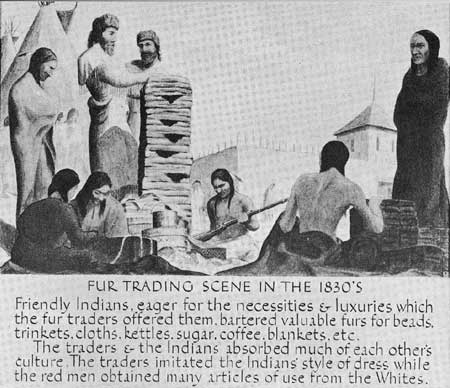|
The Upper Missouri Fur Trade Its Methods of Operation |
 |

Drawing by W. Sammons, courtesy National Park Service
By the end of the 1830's, a new fashion brought about a great change in the fur trade. For many years the beaver hat had been a symbol of distinction. Silk hats replaced those made from beaver, which were becoming increasingly scarce. As a result, the demand for beaver skins decreased and their price fell.
However, the decline of the beaver trade did not bring an end to the fur business. Other skins and peltries became increasingly important with the decline of the beaver. From 1840-1860, the trade shifted to buffalo robes and to small fur-bearing animals. During the period from 1860-1885, the business in small fur-bearing animals sharply declined and owing to the demand for leather, there was a shift in the need from buffalo robes to hides of that animal. In the 1830's the price for buffalo skins was $4.00; in the 1850's the price for robes was $3.00. Other furs and skins of importance in the trade were muskrat, mink, deer, bear, fox, wolf, ermine, badger, wild cat, and skunk. There was also a market for buffalo meat, pemmican (dried buffalo meat), and buffalo tongues which were a delicacy. [28]
The Indian trade at the posts was frequently conducted with considerable ceremony. During his visit to Fort McKenzie in 1833, Maximilian, Prince of Wied, was very much impressed with the elaborate ritual which preceded the trade. When a trading party approached, the post hoisted the flag and discharged cannon signalling that trade was about to commence. Then the principal chief and the head men, dressed in the colored great coats and round hats with tufts of feathers, given them by the company, and bringing horse or beaver skins for gifts, arrived at the trading post, they were welcomed with a salute of guns and met by the bourgeois who shook hands with them. The chiefs, after delivering their colors on a long ensign staff in military style, were followed by the warriors, all of whom were admitted to the fort, seated, fed, and given drinks and tobacco by the company. This was followed by an exchange of oratory in which the bourgeois sometimes rewarded those loyal to the company and to the whites with special presents. After dispensing with the ceremonies, trade begun. This ritual, with some variations, apparently continued to be observed for several decades at the Upper Missouri posts. [29]
Thaddeus Culbertson, who accompanied his brother Alexander up the river in 1850, described a feast which accompanied a trade at the Yankton Trading House, below Fort Pierre:
... The Indians had bought all our horses that were for sale and they came to the houses with us. There Alex had a feast prepared for them and they all appeared well satisfied. A feast for the Indians is a very simple affair—a little coffee and some gammon, or mush served in the simplest style serve them. There were 60 or 70 gathered at this one; before it was ready they came in and out and sat talking, joking and passing around the pipe just as whites spend their time when gathered for a dinner. When the things were prepared the two kettles were placed in the middle of the floor and each one was furnished with a pan of some kind to eat in, but they got no spoons or anything to answer the same purpose. Alex then made quite a long speech . . . . One of the old men then arose, shook hands with him, resumed his seat on the floor and made quite a long and animated speech. I could not understand a word but was much interested by his earnest manner. [30]
The chiefs were apparently given presents according to their rank, the more important being given more generous gifts. Larpenteur described the departure of Moose Dung, an influential chief, in 1835 following a visit to Fort Union:
July 7—The 22 Indians which arrived on the 6th started back today to their Camp with a little Ammunition and Tobacco the Moose Dung as being a very considerable man received a present of three hundred Balls and powder seventy twist[s] of tobacco two Knives four gun worms ten flints two awls one vile of Peppermint one vile of eye water and one yard of Calico . . . . Traded from them eleven good Robes. [31]
Sometimes the Indian visits to the posts were accompanied with much unpleasantness and the traders were glad to see their guests leave. One diarist recorded such a visit to Fort Union in 1855, by a party of Crows, following which the bourgeois gave them a certificate of good behavior to present to their Indian Agent. He described the visitors as:
. . . a lousy, thieving, Beggerly set of Rascals. [While at the fort] They shot a dutchman Killd a Boar cut up two carriages stole everything they could lay their hands on. Begged & Bothered Mr. Kipp to death got credits & never paid run everywhere fousugh the Fort insulted and annoyd every one. [32]

|

|
|
|
|
Last Modified: Sat, Jan 15 2005 10:00:00 am PDT |


